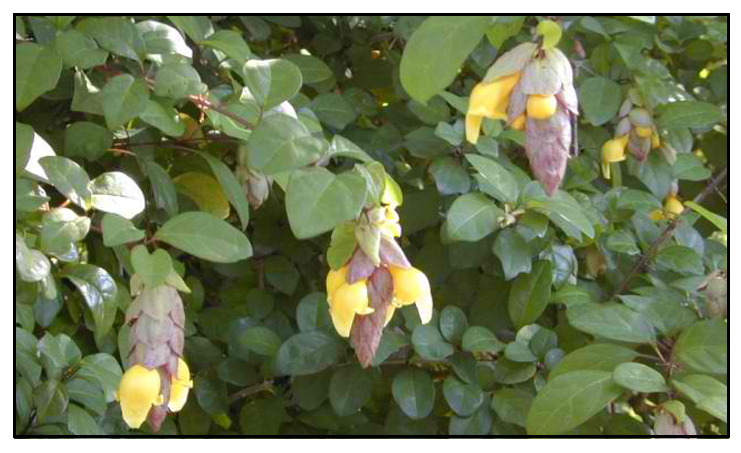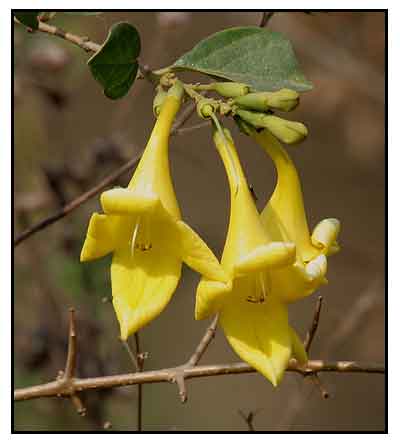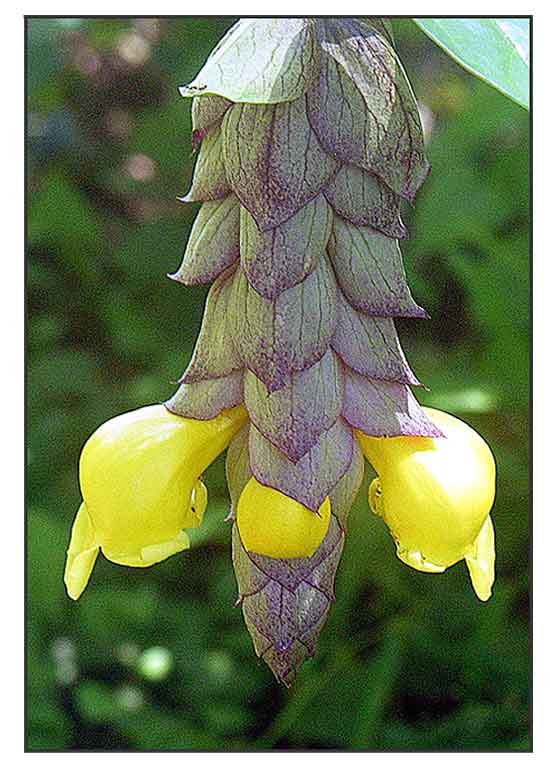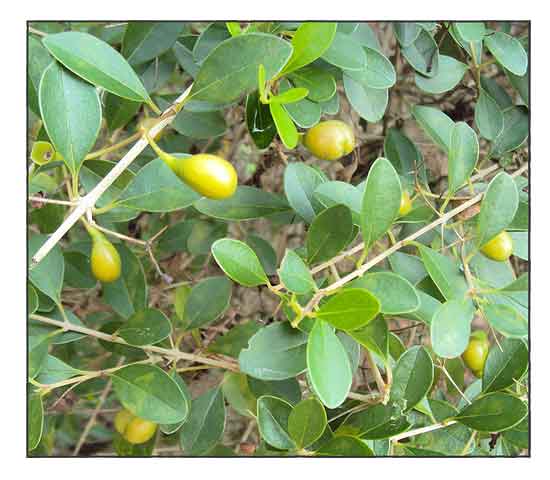 Gen info Gen info
- Gmelina philippensis is a plant species in the family Lamiaceae, previously placed on Verbenaceae.
-
Etymology: The genus name Gmelina honors Johann Gottlieb Gmelin (1709-1755), a German naturalist and traveler in Siberia, professor of botany at the Tübingen University. The species epithet philippensis refers to the Philippines, a locality of natural distribution of the species. (13)
 Botany Botany
Alipung is an erect, branched, nearly smooth shrub or small tree, 3 to 8 meters high, usually with a few stout spines on the trunk and branches. Leaves are elliptic, 4 to 8 centimeters long, entire, usually rounded or blunt at the apex and pointed at the base, and smooth beneath. Flowers are borne in short, terminal racemes, each subtended by a large, pale-green bract. The calyx is green, about 5 millimeters long. Corolla is yellow, about 4 centimeters long. Fruit is fleshy, smooth, yellow, pear-shaped, about 2 centimeters long.
Distribution
- Native to the Philippines.
-
Common in thickets and secondary forests at low and medium altitudes in Cagayan, Benguet, Pangasinan, Zambales, Bataan, Pampanga, Bulacan, Rizal, and Laguna Provinces in Luzon; and in Panay.
- Also native to Cambodia, Thailand, Vietnam.
Constituents
- Study yielded six new iridoids from aerial parts of G. philippensis viz., 6-O-alpha-L-(2"-O-, 3"-O-, 4"-O-tribenzoyl) rhamnopyranosylcatalpol, 6-O-alpha-L-(2"-O-, 3"-O-dibenzoyl, 4"-O-cis-p-coumaroyl) rhamnopyranosylcatalpol, 6-O-alpha-L-(2"-O-, 3"-O-dibenzoyl, 4"-O-trans-p-coumaroyl) rhamnopyranosylcatalpol, 6-O-alpha-L-(2"-O-benzoyl, 3"-O-trans-p-coumaroyl)rhamnopyranosylcatalpol, 6-O-alpha-L-(2"-O-, 3"-O-dibenzoyl)rhamnopyranosylcatalpol, and gmephiloside, together with five known monoacyl and diacyl rhamnopyranosylcatalpol derivatives. (7)
- Study of ethanolic extract of aerial parts isolated 11 compounds, namely: a mixture of ß-sitosterol and stigmasterol (1), gmelinol (2), apigenin (3), β-sitosterol-3-O- β-D-glucopyranoside (4), 6- O- α-L-(2″,3″,4″-tri-O -benzoyl)rhamnopyranosylcatalpol (5), a new iridoid, 6-O-α-L-(2″-O-benzoyl-4″-O-trans-p-methoxycinnamoyl)rhamnopyranosyl-1α-β-D-glucopyranoside catalpolgenin (6), vicenin-II (7), tyrosol (8), rhoifolin (9), 6-O-α-L-(2″-O-trans-p-methoxycinnamoyl)rhamnopyranosylcatalpol (10), isorhoifolin (11). (see study below) (11)
- Phytochemical screening of leaf extract
yielded carbohydrates, flavonoids, coumarins, tannins, terpenoids, saponins, steroids, alkaloids, and proteins in various organic solvents in order of increasing polarity. (see study below) (12)
 Properties Properties
- Studies suggest antipyretic, antimicrobial, antioxidant, thrombolytic, cytotoxic, antidiabetic properties.
Parts
utilized
Fruit, roots.
Uses
Folkloric
• In the Philippines, juice of fruit applied to portions of the feet affected by alipuñga (athlete's foot) and various forms of eczema.
• Fruit of juice is also considered an "anti-limatik" (a species of leech of the genus Haemadipsa).
• Fruit poultice pounded with lime, applied to the throat, for coughs.
• Mixture of the fruit with lime and garlic vigorously applied to the body in cases of dropsy.
• Fruit pounded with lime, applied as poultice to the throat for coughs.
• In India, traditionally used for diabetes. Also, used for dandruff - fruit juice applied every three days in the morning externally on the scalp.
• Juice of roots used as purgative and for treatment of fatigue. Root extracts used internally as stimulant, resolvent, and for treatment of diseases of nerves and joints. (13)
Studies
• Antipyretic:
Study of eight Pakistani medicinal plants showed Gmelina asiatica roots exhibited prominent oral antipyretic activity. (1)
• Antimicrobial:
C. viscosa and G. asiatica were tested for antimicrobial activity. The ethanolic extracts of the roots of G asiatica exhibited a broad spectrum of antimicrobial activity, esp against E coli, P vulgaris and P aeruginosa. (2) In a study of five medicinal plants for antimicrobial activity, a crude methanol extract of Gmelina philippensis exhibited 18.0 mm zone of inhibition against Bacillus cereus. (10)
 • Antimicrobial: Study showed the aqueous extract to be active against P. pseduoalcaligenes, while the methanol extract could inhibit B subtilis. (3) In a study of antimicrobial activity of five medicinal plants, a crude extract of G. philippensis showed 18.0 mm zone of inhibition against Bacillus cereus. (5) • Antimicrobial: Study showed the aqueous extract to be active against P. pseduoalcaligenes, while the methanol extract could inhibit B subtilis. (3) In a study of antimicrobial activity of five medicinal plants, a crude extract of G. philippensis showed 18.0 mm zone of inhibition against Bacillus cereus. (5)
• Antioxidant / Leaves and Flowers: Study evaluated crude methanol extract and partitionates of leaves and flowers of G. philippensis for antioxidant activity using various assays. Total phenolic content was 1.354 to 10.179 mg BAE/g with DPPH IC50 of 9.75 to 32.25 µg/ml. The variance depended on the solvent used to fractionate the crude extracts. The carbon tetrachloride soluble fraction of leaves extract exhibited the highest amount of phenolic acid. Toxicity on brine shrimp lethality bioassay showed an LC50 of 0.902 to 0.487 µg/ml. (8)
• Thrombolytic: Study evaluated methanol extracts and their pet-ether, carbon tetrachloride, chloroform and aqueous soluble partitionates of O. mungos, M. macrophylla, Gmelina philippensis and S. nodiflora for membrane stabilizing and thrombolytic activities. The carbon tetrachloride soluble fraction of G. philippensis showed 49.05% and 21.25% inhibition of hypotonic and heat induced hemolysis of RBC, respectively, with acetyl salycylic acid as reference standard. The carbon tetrachloride soluble fraction of G. philippensis showed thrombolytic activity with clot lysis value of 47.14%, with streptokinase and water as positive and negative controls with 65.00% and 3.84% lysis of clot, respectively. (9)
• Antidiabetic / Cytotoxic / Gmelinol / Aerial Parts: Study evaluated the ethanolic extract of aerial parts of G. philippensis for cytotoxic and antidiabetic activities. Eleven compounds were isolated. Compound 2, Gmelinol, exhibited strong cytotoxic activity against HepG-2 cell lines with IC50 of 3.6 µg/ml, which is more potent than standard cisplatin with IC50 of 8.7. Molecular modeling of gmelinol against diverse targets of protein kinases suggested that CDK-2 and AKT-1 could be dual kinase targets for cytotoxic action. Gmelinol also showed α-amylase inhibition with IC50 of 60.9 µg/ml, while compound 5 showed strong α-glucosidase inhibition with IC50 of 41.7 µg/mL compared to acarbose 34.7 µg/ml. Results showed the ethanolic extract of aerial parts is effective against HepG-2 cell line, α-amylase and α-glucosidase activities. Activities were attributed to compounds 2 and 5. (see constituents above) (11)
• Antibacterial / Antioxidant / Leaves: Study evaluated the bioactive compounds, antioxidant, and antibacterial activity of G. philippensis leaf extract. The aqueous extract showed highest antioxidant activity of 76.48%, 54.07% for ethanolic extract, 51.66% for ethyl acetate extract. On antimicrobial testing, the aqueous extract showed poor inhibition activity; the ethanolic extract against S. faecalis only, the petroleum ether against K. pneumonia, E. coli, and S. faecalis. (see constituents above) (12)
Availability
Wild-crafted. |

![]()

